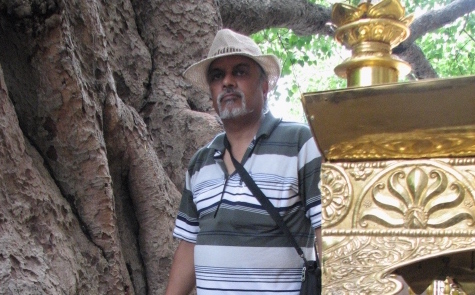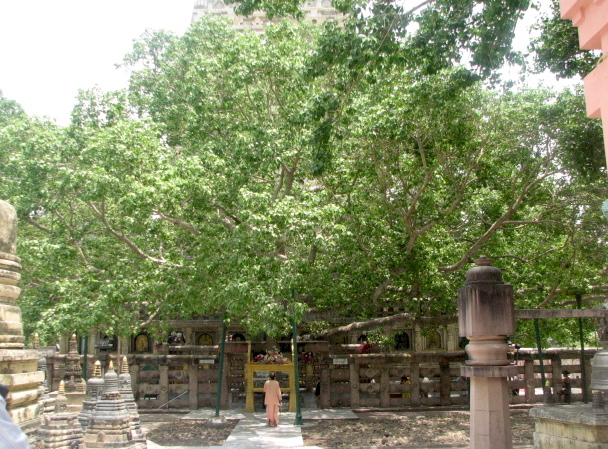The Mahabodhi temple and the sacred tree in Bodh Gaya. Image: NSK Harsh
The Mahabodhi peepal tree in Bodh Gaya, Bihar is an object of reverence for millions of Buddhists around the world, spreading its shade over the spot where the Buddha is said to have attained nirvana. Believed to be a descendant of the original Bodhi tree, the ficus religiosa currently on this spot was planted in 1881, by British archaeologist Alexander Cunningham, and then later restored and cared for by monks.About 10 years ago, the tree seemed to be drying up, despite the constant care and attention lavished on it by the roughly two million pilgrims who visit each year. The Forest Research Institute—the country’s foremost body dealing with forestry and trees—was called in from its headquarters in Dehradun to initiate a rescue. Forest pathologist NSK Harsh helped nurse this famous ficus religiosa back to health, and has taken care of it ever since.Though now retired, Harsh continues to advise the Mahabodhi Temple. He spoke to us about his special relationship with the tree.VICE: How important is the Mahabodhi tree?
NSK Harsh: First of all, it’s a living thing. And for the Buddhists, it’s a pious and a sacred tree. At times, there were scuffles between people to catch one falling leaf. However, this particular tree hasn’t been there for thousands of years, as it is generally presumed to be. It is around 130 years old, and a successor of the original tree under which the Buddha is supposed to have sat. Though I have not looked after it, in 2009 I visited the Jaya Shri Mahabodhi tree in Anuradhapur, Sri Lanka, said to be the oldest living human-planted tree in the world. It is believed to have been planted in 288 BC, from a cutting of the original Mahabodhi tree in Bodh Gaya.Have you tended any other famous or notable trees in the world?
Though I have not looked after it, in 2009 I visited the Jaya Shri Mahabodhi tree in Anuradhapur, Sri Lanka, said to be the oldest living human-planted tree in the world. It is believed to have been planted in 288 BC, from a cutting of the original Mahabodhi tree in Bodh Gaya.Have you tended any other famous or notable trees in the world?
I have also worked for sacred trees in Cambodia. There is a famous heritage tree in Ta Prohm temple, or “tree temple” in Cambodia. It is known scientifically as Tetrameles nudiflora and locally as spung.In India, I have taken care of the tree at Sai Baba Santhan in Shirdi under which Sai Baba is said to have attained his diksha. There is one banyan tree in Kurukshetra, where it is said Krishna gave the sermon of Gita. I have also tended to the rudraksh tree in Shantikunj, in Haridwar.Has climate change affected the health of the Mahabodhi?
Due to global warming, the temperature may have risen by a maximum of one degree. This minor rise will not affect the wood or the root, which is well protected under the soil. However, this may affect the flowering cycle.The weather this year is warmer than it used to be this time of the year, which may affect the natural cycle of the foliage. The normal “leaf-fall” period is in January or February, which may be delayed this time.Are there other factors negatively affecting the tree?
There is white marble flooring underneath the tree, which gets hot during summers. The wall of the Mahabodhi Temple, grey in colour, also emits heat. This excess heat causes premature defoliation at times. After taking my suggestions, the marble floor is mopped twice a day, around 11 AM and 4 PM.Does pollution affect the tree too?
Certainly. Layers of dust on the leaf affects photosynthesis. If there are toxic substances in the air like carbon monoxide by vehicular pollution, it may also cause problems to the tree. What about human interference and presence?
What about human interference and presence?
Locals used to collect the fallen leaves, branches and figs. Some sold the leaves to foreign devotees at around $10 per leaf. I asked the temple management to collect the waste and make a powder of it, which could then be used for religious purposes or to be given as a memento the visiting foreign dignitaries.People used to burn incense sticks, diyas and candles below the tree. A separate place away from the tree was found to “offer light” to it. We also stopped the devotees from offering milk to the tree.How often did you have to inspect the tree?
In the beginning, I used to go there thrice a year: once in winter, once in the rainy season and once at the onset of summer. At times, there were even four visits in the year. After my retirement, the temple committee has personally asked me to come and see the tree and advise the FRI scientists who are currently looking after it.What kinds of things have you done to increase the lifespan of the tree?
I employ sense and science. We encased the metallic props beneath the branches with rubber and foam bedding, so that the branches are not damaged. The foliage was regularly removed and manure added. We were regularly finding ways to save the tree from diseases like mealybug. Any injuries to the stem or branches were treated with a special paste. The tree was also suffering from a scarcity of major nutrients like nitrogen, copper and potash. To counter that, we applied micronutrients to the old roots once or twice a year, depending upon the requirement.How long do you think the tree may survive?
The peepal tree has a comparatively long life, and keeps on regenerating itself, not just through its seeds but also through its roots. When main trunk dies, a new one will rise and take its place. This is the circle of life. I believe that that this tree may survive another 50 years. Its descendant has already started to appear and it will take over when the time comes.
Advertisement
NSK Harsh: First of all, it’s a living thing. And for the Buddhists, it’s a pious and a sacred tree. At times, there were scuffles between people to catch one falling leaf. However, this particular tree hasn’t been there for thousands of years, as it is generally presumed to be. It is around 130 years old, and a successor of the original tree under which the Buddha is supposed to have sat.

I have also worked for sacred trees in Cambodia. There is a famous heritage tree in Ta Prohm temple, or “tree temple” in Cambodia. It is known scientifically as Tetrameles nudiflora and locally as spung.
Advertisement
Due to global warming, the temperature may have risen by a maximum of one degree. This minor rise will not affect the wood or the root, which is well protected under the soil. However, this may affect the flowering cycle.The weather this year is warmer than it used to be this time of the year, which may affect the natural cycle of the foliage. The normal “leaf-fall” period is in January or February, which may be delayed this time.Are there other factors negatively affecting the tree?
There is white marble flooring underneath the tree, which gets hot during summers. The wall of the Mahabodhi Temple, grey in colour, also emits heat. This excess heat causes premature defoliation at times. After taking my suggestions, the marble floor is mopped twice a day, around 11 AM and 4 PM.Does pollution affect the tree too?
Certainly. Layers of dust on the leaf affects photosynthesis. If there are toxic substances in the air like carbon monoxide by vehicular pollution, it may also cause problems to the tree.

Locals used to collect the fallen leaves, branches and figs. Some sold the leaves to foreign devotees at around $10 per leaf. I asked the temple management to collect the waste and make a powder of it, which could then be used for religious purposes or to be given as a memento the visiting foreign dignitaries.People used to burn incense sticks, diyas and candles below the tree. A separate place away from the tree was found to “offer light” to it. We also stopped the devotees from offering milk to the tree.How often did you have to inspect the tree?
In the beginning, I used to go there thrice a year: once in winter, once in the rainy season and once at the onset of summer. At times, there were even four visits in the year. After my retirement, the temple committee has personally asked me to come and see the tree and advise the FRI scientists who are currently looking after it.What kinds of things have you done to increase the lifespan of the tree?
I employ sense and science. We encased the metallic props beneath the branches with rubber and foam bedding, so that the branches are not damaged. The foliage was regularly removed and manure added. We were regularly finding ways to save the tree from diseases like mealybug. Any injuries to the stem or branches were treated with a special paste. The tree was also suffering from a scarcity of major nutrients like nitrogen, copper and potash. To counter that, we applied micronutrients to the old roots once or twice a year, depending upon the requirement.How long do you think the tree may survive?
The peepal tree has a comparatively long life, and keeps on regenerating itself, not just through its seeds but also through its roots. When main trunk dies, a new one will rise and take its place. This is the circle of life. I believe that that this tree may survive another 50 years. Its descendant has already started to appear and it will take over when the time comes.